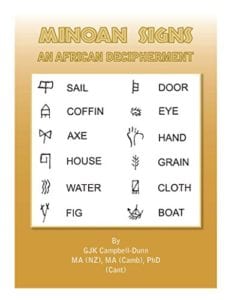
About the Book:
The Minoan Linear Signs have now been explained as Niger-Congo. And some twenty five full words have been related to Fula. Problematic words of Greek have also been given tentative African etymologies. A new African language, four thousand years old, has come to light in the Linear A documents. So we claim a decipherment, or at least the beginnings of a decipherment. Only time will give us a full solution. But we can say that the “unknown language” is no longer unknown. It is African.
Read an Excerpt:
Featured in Feb/Mar 2017 Issue: Crossover Edition
It is about a hundred years now since Sir Arthur Evans discovered the Minoan scripts. Linear B was deciphered in the fifties by Ventris, with subsequent work by John Chadwick and others. Linear A has continued to pose a problem. But that problem has now been solved.
The texts of Linear A are Niger-Congo. That is, the signs of the script, so far as their phonetics are known, can be identified as objects (bird, house, sun, eye, slave etc) matching Niger-Congo names (ku, su, gwe, do, kwa). This is now true of signs including Chadwick’s NI “fig” and SA “flax”.
The identification of the Ankh-sign, phonetic ZA, with PWS dza “blood” (blood soul) or PCS *za / *ja was particularly significant. Linear A Z is known to represent [dz]. Over 75 signs are now almost certain.
The Vai script from West Africa provides some parallels. Thus Vai kpu, kpa, mba signs match the forms of Linear A KU “bird”, KA “wheel” and WA “cloth” ; Vai do matches Linear A RO “cross” = “total”, Vai mã matches Linear A ME “goat” and Vai nã matches Linear A NE “water”. As one might expect the matches are not exact. And in any case the Vai script appears designed not for Vai, but some other language.
Chadwick suggested that KURO “total” and KIRO “deficit” were known words of Linear A. Both of these have now been explained as Niger-Congo. KU and KI are quantifying prefixes. RO means “total”.
We can now explain full words from the Linear A tablets, of which MARU = Fula mbaalu “sheep” is the best, but not the only example. Chadwick identified this word as the same as Linear B maro and compared Greek mallos ”fleece”. Many years ago Professor Kidd pointed out to me that Vergil’s surname Maro was the Latin equivalent. Greek had added a final –s. Most of the words are nouns.
We are now sure that Linear A (Minoan) was a member of the Atlantic subgroup of Niger-Congo, quite close to Fula. But Minoan is nearer in its morphology to Gola. Gola has the labiovelar and is also called Gura.
